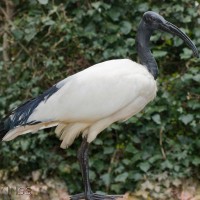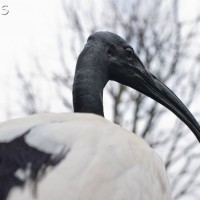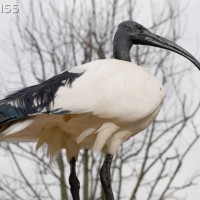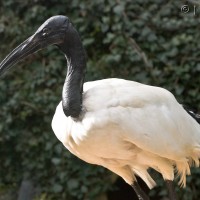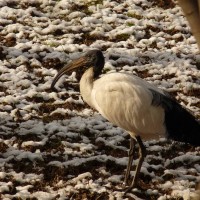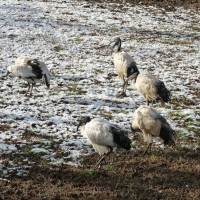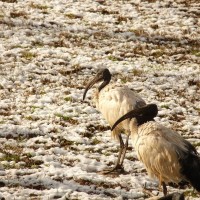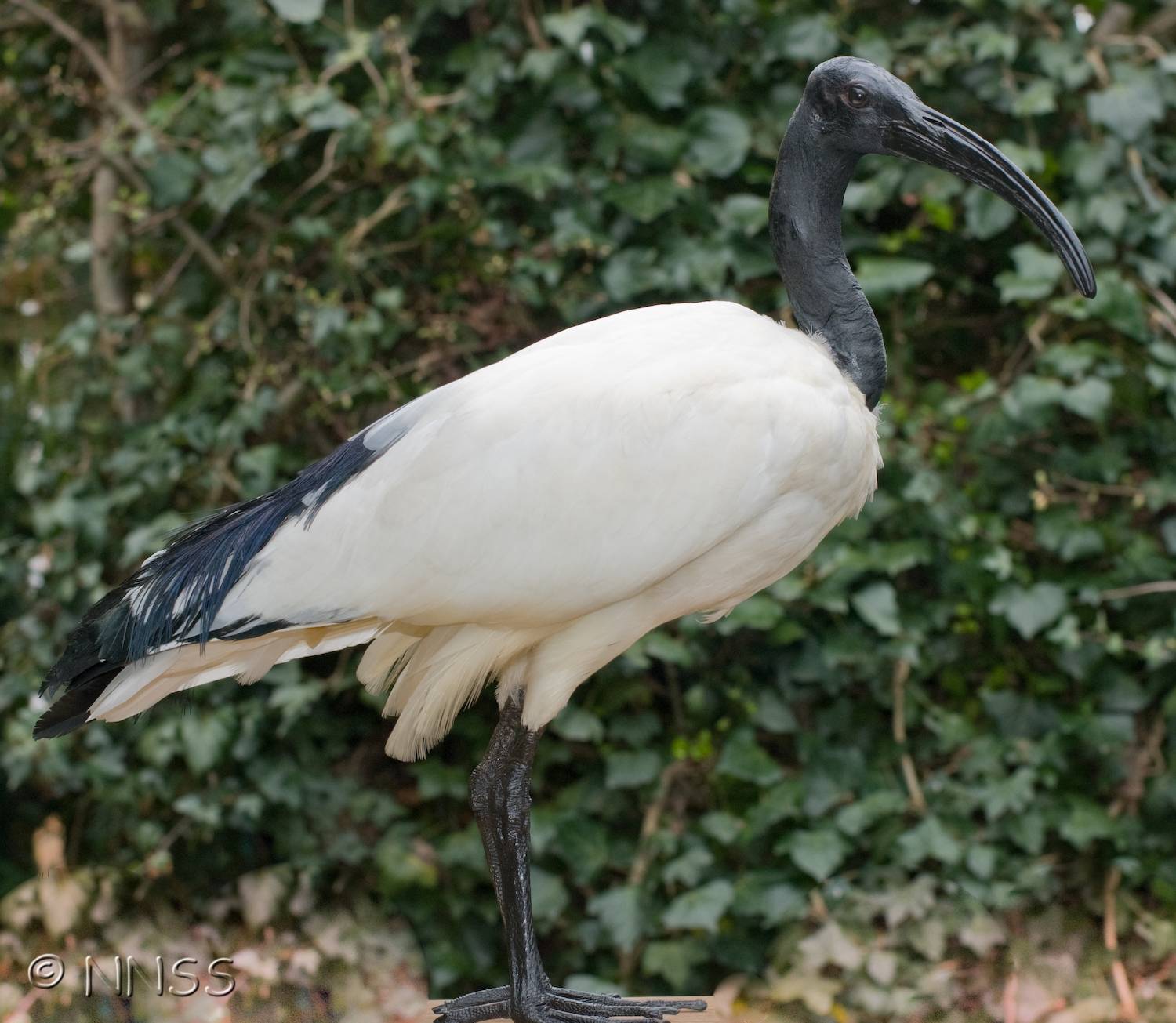
Sacred Ibis - Threskiornis aethiopicus
Expand and collapse the sections below by clicking on the title or + / - icons.
Short description of Threskiornis aethiopicus, Sacred Ibis
A large, mainly white bird with black head, neck and long, heavy, downcurved bill, black scapular plumes and long black legs. In flight, it can be identified by the narrow black trailing edge to the broad white wings, and the characteristic dark head, neck and bill.
Impact summary: Threskiornis aethiopicus, Sacred Ibis
No impacts have yet been documented in GB, but sacred ibises can be serious predators of eggs and chicks, for example in French tern colonies, and their presence may have implications for public health.
Habitat summary: Threskiornis aethiopicus, Sacred Ibis
The main habitats used are wet grasslands and other shallow wetlands, but birds sometimes also feed at human sites, such as landfill sites, in arable fields and in intertidal zones at estuaries.
Overview table
| Environment | Terrestrial |
|---|---|
| Species status | Non-Native |
| Native range | Angola, Burkina, Burundi, Benin, Botswana, Central African Republic, Congo, Ivory Coast, Cameroon, Djibouti, Eritrea, Ethiopia, Gabon, Ghana, Gambia, Guinea, Equatorial Guinea, Guinea-Bissau, Iraq, Iran, Kenya, Comoros, Liberia, Lesotho, Madagascar, Mali, Mauritania, Malawi, Mozambique, Namibia, Niger, Nigeria, Rwanda, Sudan, Sierra Leone, Senegal, Somalia, Swaziland, Chad, Togo, Tanzania, Uganda, North Yemen, South Yemen, Zambia, Zimbabwe, South Africa |
| Functional type | Predator |
| Status in England | Non-Native |
| Status in Scotland | Non-Native |
| Status in Wales | Non-Native |
| Location of first record | Pantyfynnon |
| Date of first record | 1995 |
Origin
Sacred ibis is widespread and numerous in Africa south of the Sahara, and has a small and declining population in Iran and Iraq. Vagrants have occurred in the Arabian Peninsula and north to Kazakhstan.
First Record
First record from the wild in GB in 1995.
Pathway and Method
Sacred ibises in GB are most likely to be escapes from captivity, perhaps originating mainly from within GB but also from continental Europe; vagrants from the established introduced populations in France and other European countries may also occur.
Species Status
During the 1970s and 1980s, several zoos in Europe and elsewhere attempted to establish free-flying breeding colonies within their grounds. These led to the establishment of wild-living colonies. In western France, more than 1,200 pairs now breed at several scattered sites.
Dispersal Mechanisms
Young from colonies in western France have travelled at least as far as the Belgian border. Since first breeding in Brittany in 1993, colonies have spread 350 km south along the French coast.
Reproduction
Sacred ibises nest in colonies, sometimes alongside herons and egrets, building nests in trees or on the ground.
Known Predators/Herbivores
Various mammal species may predate eggs or chicks. In the African native range, predation by large birds of prey (such as eagles) can occur, but this is unlikely within GB.
Resistant Stages
None.
Habitat Occupied in GB
Birds have been recorded in GB mainly at coastal marshes and occasionally at inland reservoirs.
More than 30 individuals have been recorded so far. These have been mainly in England and Wales, north to North Yorkshire.
Environmental Impact
Sacred ibises are largely carnivorous opportunistic feeders. In France, their diet includes earthworms, insects, fish, small rodents, molluscs, crustaceans and amphibians, and they may have localised impacts on some populations of these species. They also prey upon the eggs or young of other bird species. In July 2004 in France, two sacred ibises consumed all the eggs in a sandwich tern Sterna sandvicensis colony (30 nests) inside four hours. Sacred ibises compete successfully for nest sites with cattle egrets and little egrets.
Health and Social Impact
Sacred ibises feed regularly on rubbish dumps throughout the year, and may also feed on slurry pits. They often roost close to human habitation and therefore there have been some concerns in France about the implications for public health.
Economic Impact
None known.
Identification
BirdLife International fact sheet
Biology, ecology, spread, vectors
Clergeau, P. & Yésou, P. (2006) Behavioural flexibility and numerous potential sources of introduction for the sacred ibis: causes of concern in western Europe? Biological Invasions, 8, 1381–1388.
Herring, G. & Gawlik, D.E. (2008) Potential for successful population establishment of the nonindigenous sacred ibis in the Florida Everglades. Biological Invasions, 10, 969–976. DOI 10.1007/s10530-007-9174-1
Ottens, G. (2006) Sacred Ibises in the Netherlands. Birding World, 19, 84.
Yésou, P. & Clergeau, P. (2005) Sacred Ibis: a new invasive species in Europe. Birding World, 18, 517–526. www.birdingworld.co.uk/images/SacredIbises.pdf
Management and impact
Kayser, Y., Clément, D. & Gauthier-Clerc, M. (2005) L'ibis sacré Threskiornis aethiopicus sur le littoral méditerranéen français: impact sur l'avifaune. Ornithos, 12, 84–86.
Williams, A.J. & Ward, V.L. (2006) Sacred Ibis and Gray Heron predation of Cape Cormorant eggs and chicks; and a review of ciconiiform birds as seabird predators. Waterbirds, 29, 321–327.
General
BirdLife International fact sheet
https://www.cabi.org/isc/datasheet/62201
http://www.nonnativespecies.org/downloadDocument.cfm?id=59
Alert status
Sacred Ibis, Threskiornis aethiopicus is an Alert Species
Find more information about this alert and the full list of alert species.
Spotted this species?
Distribution map
View the Distribution map for Sacred Ibis, Threskiornis aethiopicus from NBN Atlas

Native range map
View an interactive native range map for Sacred Ibis, Threskiornis aethiopicus
Risk assessment
Risk assessment for Threskiornis aethiopicus. See a full list of non-native species Risk assessments.
Legislation
Sacred ibis, Threskiornis aethiopicus, is a Species of Special concern. Read more about Non-native species legislation.

